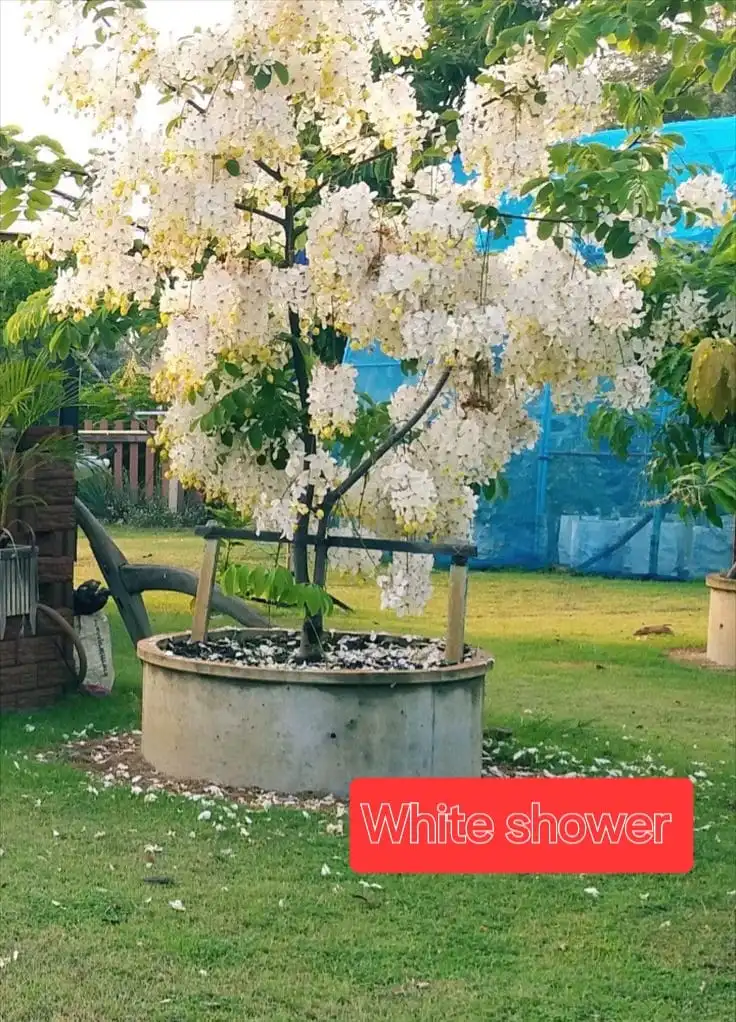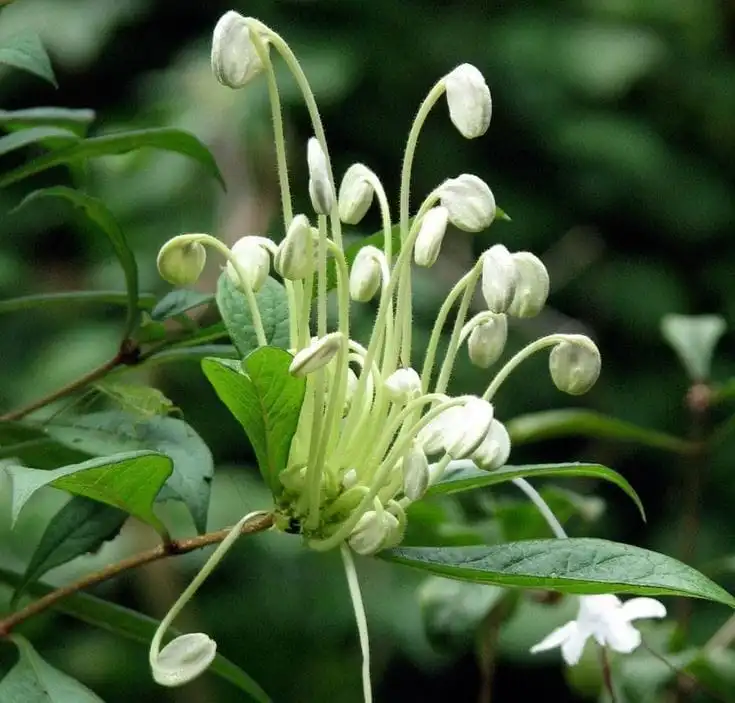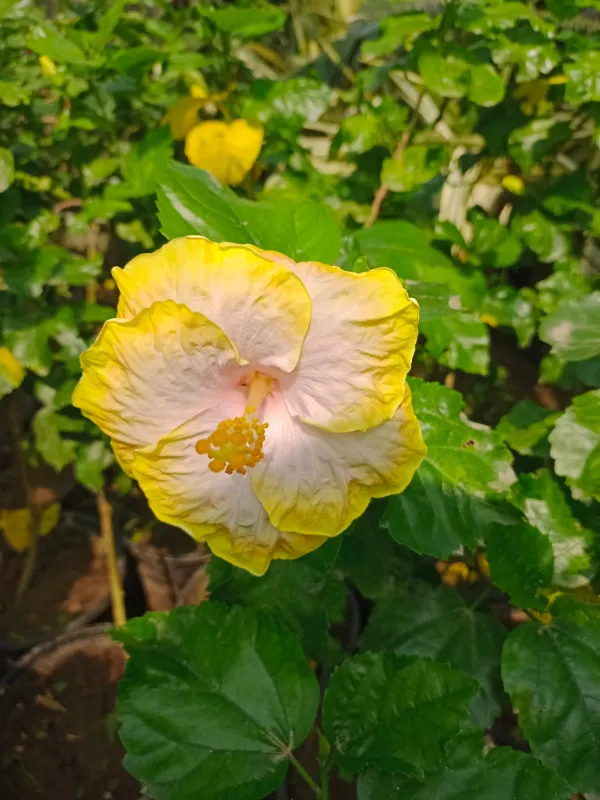Benefits of the Queen’s Hospital White Shower Tree
The Queen’s Hospital White Shower Tree, a lesser-known but exceptionally beautiful member of the Cassia genus, offers a multitude of benefits that go beyond its ornamental charm. Scientifically known as Cassia javanica ‘Alba’, this elegant tree is a variant of the Java cassia or pink shower tree, but it produces stunning white blossoms. The tree has gained popularity in public gardens, hospital grounds, and residential landscapes for its aesthetic beauty, cultural symbolism, and ecological significance.
The Queen’s Hospital White Shower Tree is much more than an ornamental tree—it’s a beacon of beauty, healing, and ecological significance.
1. Ornamental Beauty and Landscape Enhancement
One of the most significant benefits of the Queen’s Hospital White Shower Tree is its stunning visual appeal. The tree’s delicate, white, cascading blooms resemble a floral shower, creating a dramatic and peaceful presence in any garden or urban landscape.
Seasonal Display: The tree blooms abundantly in late spring and early summer, with a full canopy of white flowers that create a breathtaking display.
Shade Provider: With its wide, spreading crown and dense foliage, the tree provides ample shade, making it a popular choice for hospital courtyards, parks, and roadside plantings.
Design Versatility: It can be used in urban boulevards, botanical gardens, or residential yards, blending seamlessly into modern and traditional landscape designs.
2. Psychological and Emotional Benefits
The Queen’s Hospital White Shower Tree is not just admired for its beauty but also contributes to emotional and psychological well-being.
Therapeutic Landscaping: In hospital environments, the tree serves as a symbol of peace and healing. Its serene white blossoms evoke feelings of calmness and hope, which are crucial for patient recovery and mental peace.
Mood Enhancement: Studies have shown that natural settings and greenery reduce stress, anxiety, and depression. The gentle white hues of the shower tree amplify these benefits by offering visual relief and promoting inner tranquility.
Memory Association: Because it is often planted in hospitals and places of remembrance, the tree can hold sentimental value and be associated with healing or the memory of loved ones.
3. Environmental and Ecological Contributions
The Queen’s Hospital White Shower Tree offers numerous ecological advantages, making it a valuable addition to sustainable urban development.
Air Purification: Like other trees, it filters airborne pollutants and increases oxygen levels, improving air quality.
Carbon Sequestration: The tree absorbs carbon dioxide and helps mitigate the effects of climate change.
Soil Stabilization: Its deep root system helps in controlling erosion and stabilizing soil, especially in areas vulnerable to runoff and degradation.
Wildlife Support: The tree attracts birds, bees, and butterflies, playing a role in urban biodiversity and pollinator support.
4. Cultural and Symbolic Significance
Although not as widely celebrated as some other flowering trees, the Queen’s Hospital White Shower Tree holds symbolic importance in the places it is planted.
Symbol of Peace and Healing: Particularly in hospital grounds and memorial gardens, the tree is considered a symbol of healing, purity, and peace.
Ceremonial Use: In some cultures, white flowers are used in religious and commemorative ceremonies, making this tree a meaningful feature in spiritual spaces.
5. Low Maintenance and Resilience
One of the practical advantages of the Queen’s Hospital White Shower Tree is its adaptability and low-maintenance nature.
Drought Tolerance: Once established, it can tolerate periods of drought, making it ideal for regions with irregular rainfall.
Pest Resistance: The tree has relatively few pest or disease problems, requiring minimal chemical treatment.
Longevity: It is a long-living tree with a strong root system and hardy trunk, ensuring years of steady growth and beauty.
Minimal Pruning Needs: While it may require occasional shaping, the tree maintains a beautiful natural form without frequent intervention.
6. Educational and Research Opportunities
The tree also serves as a valuable educational tool for students, gardeners, and researchers.
Botanical Education: It can be included in botanical gardens and educational tours to demonstrate plant diversity and ecological functions.
Plant Behavior Studies: Researchers can study its pollination, flowering cycles, and resilience to environmental stress.
Therapeutic Horticulture: The tree may be used in studies related to horticultural therapy and the benefits of green spaces on human health.
7. Enhancing Urban Aesthetics and Property Value
In urban planning and residential landscaping, the Queen’s Hospital White Shower Tree adds both aesthetic and economic value.
Urban Beautification: It elevates the visual quality of streets, hospitals, and campuses by adding seasonal vibrancy.
Property Value: Trees that bloom beautifully and provide shade can increase the appeal and value of homes and buildings nearby.
Community Pride: Well-maintained public trees can contribute to civic pride and community engagement.
Note:The Queen’s Hospital White Shower Tree is much more than an ornamental tree—it’s a beacon of beauty, healing, and ecological significance.
8. Improving Microclimates
Trees significantly impact the microclimates around them, and this tree is no exception.
Temperature Moderation: It helps cool down the surrounding area by providing shade and releasing moisture through transpiration.
Windbreak Effects: Its dense foliage can act as a natural wind barrier, offering protection to buildings and smaller plants.
Noise Reduction: By absorbing sound waves, the tree can help reduce urban noise pollution, particularly in busy areas like hospitals and highways.
9. Eco-Friendly Commemoration Option
Planting a Queen’s Hospital White Shower Tree can serve as a meaningful and environmentally conscious way to commemorate an individual or event.
Memorial Trees: Families and institutions often plant these trees as living tributes to loved ones or in honor of significant achievements.
Green Legacy: Rather than opting for artificial tributes, this tree provides a sustainable and living legacy that contributes to environmental well-being.
10. Potential Medicinal Uses (Under Research)
While the primary benefits of this tree are ornamental and ecological, some Cassia species are known for their medicinal properties. While specific research on the white variant is limited, the genus offers promising insights.
Antibacterial Properties: Some species of Cassia have demonstrated antibacterial and antifungal properties in traditional medicine.
Antioxidant Activity: The leaves and flowers of related Cassia trees have been studied for antioxidant content, which could have health-promoting benefits.
Laxative Qualities: Cassia fistula, a close relative, is used as a natural laxative. It is unclear whether the white-flowering hybrid shares these properties, but ongoing botanical research may reveal new applications.
11. Pollinator Habitat
The tree plays an essential role in supporting local ecosystems by offering a habitat and food source for various pollinators.
Bees and Butterflies: Its abundant nectar attracts pollinating insects that are vital to biodiversity and food production.
Bird Attraction: Birds often visit the tree for shade and nesting, adding to its ecological diversity and charm.
Pollination Education: It can be used to teach about the importance of native pollinators in school gardens and nature reserves.
12. Contribution to Green Infrastructure
In sustainable city planning, trees like the Queen’s Hospital White Shower Tree are critical components of green infrastructure.
Rainwater Management: It helps absorb excess rainwater and reduces pressure on urban drainage systems.
Urban Heat Island Mitigation: By shading streets and buildings, it contributes to reducing heat buildup in city environments.
Storm Resistance: Its strong structure makes it reliable in adverse weather conditions, helping cities maintain green coverage even after storms.
13. Aesthetic Contrast and Visual Texture
The tree’s white flowers provide a striking contrast to other colorful trees and plants.
Design Harmony: It balances brightly colored blooms, offering visual relief and creating focal points in design.
Seasonal Highlighting: Because it blooms when many other trees are not in flower, it becomes a seasonal highlight in any landscape.
Conclusion
The Queen’s Hospital White Shower Tree is much more than an ornamental tree—it’s a beacon of beauty, healing, and ecological significance. From hospital gardens to public parks and private properties, this tree offers immense value through its visual elegance, environmental benefits, and low maintenance requirements.
Its ability to calm the mind, purify the air, attract pollinators, and stand as a symbol of peace and renewal makes it an ideal tree for diverse applications. Whether used in therapeutic landscaping, memorial plantings, or sustainable city design, the Queen’s Hospital White Shower Tree continues to prove that nature, when carefully integrated into our lives, can bring healing, harmony, and hope.
Would you like this content broken into blog sections or formatted for SEO with headings, meta descriptions, and focus keywords?









Leave a Reply